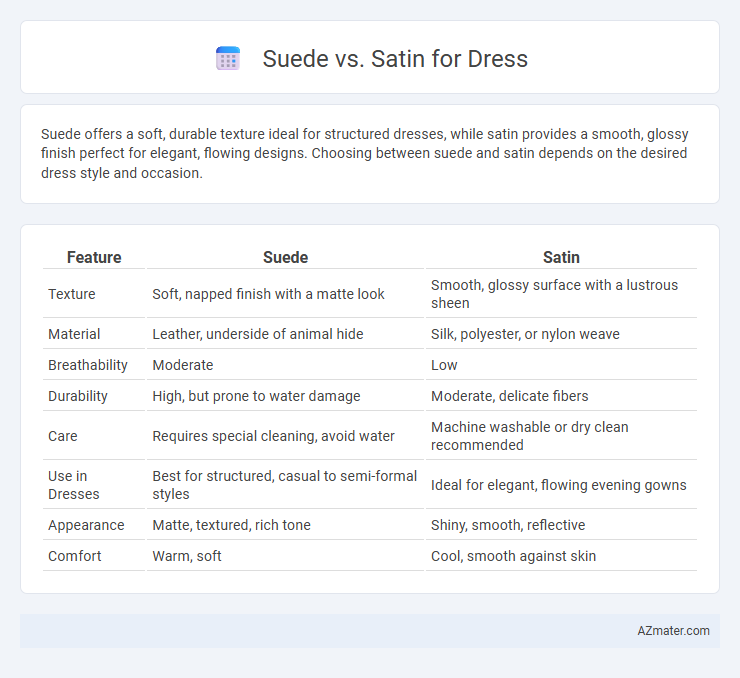Suede offers a soft, durable texture ideal for structured dresses, while satin provides a smooth, glossy finish perfect for elegant, flowing designs. Choosing between suede and satin depends on the desired dress style and occasion.
Table of Comparison
| Feature | Suede | Satin |
|---|---|---|
| Texture | Soft, napped finish with a matte look | Smooth, glossy surface with a lustrous sheen |
| Material | Leather, underside of animal hide | Silk, polyester, or nylon weave |
| Breathability | Moderate | Low |
| Durability | High, but prone to water damage | Moderate, delicate fibers |
| Care | Requires special cleaning, avoid water | Machine washable or dry clean recommended |
| Use in Dresses | Best for structured, casual to semi-formal styles | Ideal for elegant, flowing evening gowns |
| Appearance | Matte, textured, rich tone | Shiny, smooth, reflective |
| Comfort | Warm, soft | Cool, smooth against skin |
Introduction to Suede and Satin
Suede, a type of leather with a napped finish, offers a soft texture and matte appearance, making it ideal for structured, durable dresses with a luxurious feel. Satin, characterized by a smooth, glossy surface and high sheen, is typically woven from silk or synthetic fibers, perfect for elegant and flowing dress designs. Choosing between suede and satin depends on the desired aesthetic, comfort, and occasion, highlighting suede's warmth and texture versus satin's sleekness and shine.
Key Differences Between Suede and Satin
Suede is a soft, textured leather with a matte finish, providing warmth and durability, while satin is a smooth, glossy fabric made from silk or synthetic fibers, known for its luxurious sheen and lightweight feel. Suede dresses offer a more rugged and casual appearance, ideal for cooler weather, whereas satin dresses exude elegance and are preferred for formal events. The key differences lie in their material composition, texture, breathability, and suitability for varying occasions and climates.
Suede: Characteristics and Benefits
Suede is a soft, napped leather known for its velvety texture and luxurious appearance, making it an elegant choice for dresses that require a sophisticated yet tactile feel. Its durability and natural breathability provide comfort and longevity, while the unique matte finish adds depth and richness to garment designs. Suede's ability to hold rich, vibrant colors enhances its versatility in fashion, offering stylish options for both casual and formal wear.
Satin: Features and Advantages
Satin fabric for dresses offers a smooth, glossy surface that enhances elegance and adds a luxurious sheen, making it ideal for formal occasions and evening wear. Its soft texture drapes beautifully, providing comfort and a flattering silhouette while resisting wrinkles better than suede. Satin's lightweight and breathable qualities ensure ease of movement and lasting wearability, distinguishing it from the heavier, more rigid suede material.
Comfort and Wearability
Suede offers a soft, textured feel ideal for cooler weather but may lack breathability, making it less comfortable for extended wear in warm climates. Satin boasts a smooth, silky surface that enhances comfort and allows for better airflow, making it more suitable for all-day wear in diverse temperatures. Both fabrics provide unique aesthetics, yet satin generally offers superior comfort and wearability for dresses due to its lightweight and breathable nature.
Durability and Maintenance
Suede offers moderate durability but requires careful maintenance to prevent water damage and stains, making it less ideal for everyday wear. Satin, while smooth and elegant, is more prone to snags and requires delicate washing methods to maintain its sheen and texture. Choosing between suede and satin depends on balancing the need for durability with the level of maintenance one is willing to undertake.
Aesthetic Appeal and Style
Suede offers a matte, textured finish that conveys a rich, luxurious aesthetic, making it ideal for casual and edgy dress styles, while satin provides a smooth, glossy surface that enhances elegance and sophistication, perfect for formal and evening wear. The soft nap of suede absorbs light for a muted yet tactile appeal, contrasting with satin's reflective sheen that highlights curves and movement. Choosing between suede and satin depends on the desired dress silhouette and ambiance, with suede exuding warmth and rugged charm, and satin emphasizing sleekness and glamour.
Best Occasions for Suede vs Satin Dresses
Suede dresses are ideal for cooler weather events such as fall weddings, outdoor parties, and evening gatherings due to their warm texture and rich appearance. Satin dresses are best suited for formal occasions like weddings, proms, and cocktail parties where their smooth, glossy finish enhances elegance and sophistication. Choosing between suede and satin depends largely on the event's season, formality, and desired aesthetic impact.
Choosing the Right Fabric for Your Dress
Suede offers a rich, textured appearance with a soft, matte finish ideal for structured dresses and cooler weather, while satin provides a smooth, glossy surface perfect for elegant, flowing gowns and warmer climates. Consider the occasion and desired silhouette; suede evokes a casual, luxurious vibe suited for fall and winter, whereas satin lends itself to formal events with its sleek drape and radiant sheen. Fabric breathability and care requirements also influence choice, as suede demands more maintenance, whereas satin typically allows for easier cleaning and comfort.
Conclusion: Which is Better, Suede or Satin?
Satin is better for dresses when a smooth, glossy finish and elegant drape are desired, making it ideal for formal occasions and evening wear. Suede offers a soft, textured feel with a matte appearance, better suited for casual or fall/winter attire due to its warmth and durability. Choosing between suede and satin depends on occasion, season, and the desired aesthetic, with satin excelling in luxury appeal and suede providing cozy sophistication.

Infographic: Suede vs Satin for Dress
 azmater.com
azmater.com